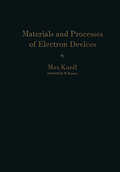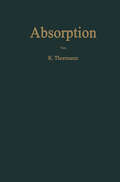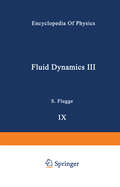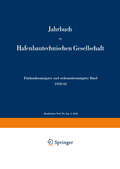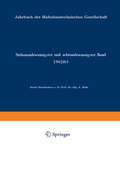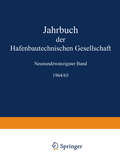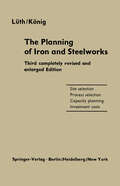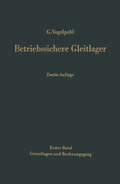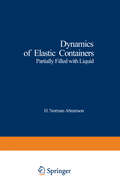- Table View
- List View
Fluid Dynamics I / Strömungsmechanik I (Handbuch der Physik Encyclopedia of Physics #3 / 8 / 1)
by C. A. Truesdell343 Whilst this may be so it is also true that this in itself is not sufficient to deter mine it completely. In fact the extent of the dead air region and the behaviour of the shear layer are also of prime importance and in short a unified treatment comprising external flow, boundary layer, shear layer and dead air region becomes necessary to complete the investigation. This would take us outside the scope of the present article and for the substantial progress that has been made towards such a treatment the reader is referred to a paper by HOLDER and GADD 1 and its comprehensive list of references. v. Heat transfer in incompressible boundary layers. 25. Introduction. The term fluid includes gases and liquids. Both gases and liquids are to some extent compressible but in many problems of fluid flow the density changes occurring are small. When they are small enough to be negligible we can regard the flow as incompressible. In Chap. IV we have established the equations for compressible flow of gases and these can of course be used to deter mine when density changes in a gas flow are in fact negligible. Broadly speaking this will be so when the temperature changes as determined by the energy equation are small enough.
Nuclear Reactions II: Theory / Kernreaktionen II: Theorie (Handbuch der Physik Encyclopedia of Physics #8 / 41 / 1)
by S. FlüggeNuclear Instrumentation I / Instrumentelle Hilfsmittel der Kernphysik I (Handbuch der Physik Encyclopedia of Physics #8 / 44)
by Edward CreutzMaterials and Processes of Electron Devices: Werkstoffe und Verfahren zur Herstellung von Entladungsgeräten / Matériaux et procédés pour la construction d’appareils de décharges électriques / Materiales y procesos de fabricación para elementos electrónicos
by Max KnollThis bookis intended to be of assistance to the physicist or engineer concerned with designing and building electron devices such as high-vacuum transmitter- or amplifier tubes, gas- or vapor-filled rectifiers, thyratrons, X-ray or luminescent tubes, glow or incandescent lamps, Geiger- or ionization counters, vacuum photo cells, photoconductive cells, selenium-, germanium- or silicon rectifiers or trans istors. For this purpose, extensive information is required concerning the compo sition, behavior and handling of materials as well as a thorough knowledge of high-vacuum technique necessary for processing electron devices after their assembly. The text covers the preparation and working of materials used in these devices; the finishing methods for vacuum tubes (especially degassing, pumping and getter procedures); and different production steps of solid state devices. This book contains about 2300 references indicated in the text by the author's name and reference number. At the end of each chapter the references themselves are listed alphabetically by the author's name and with the title sometimes abbreviated. In accordance with the purpose of the book, "first" publications are quoted only when they contain up-to-date-knowledge of the subject in question. Patents are treated as references. The quotation of a patent gives only a hint of the technical details described there. Mentioning, or not mentioning, a patent does not imply a statement concerning its importance or validity or warning against imitation. Expired patents are named in addition to ones still valid.
Berechnung von gußeisernen emaillierten Druckbehältern: Messungen an einem 6 cbm-Rührwerksbehälter (Verfahrenstechnik in Einzeldarstellungen #7)
by Günther Matz Peter GayerFluid Dynamics / Strömungsmechanik (Handbuch der Physik Encyclopedia of Physics #3 / 9)
by C. A. TruesdellSect 2. 317 tinuity surfaces 1. This suggests that a wake pressure Pw be associated with each flow past a bluff body, and that a wake parameter (2. 4) which plays the same role as the cavitation parameter (2. 1), be defined for the flow. This idea has been made the basis of a modified wake theory (ef. Sect. 11) which proves to be in good qu- titative agreement with pressure and drag measurements. It should be emphasized, however, that un h like the cavitation number, the wake parameter is a quantity which is not known a priori, and must be empirically determined in each case. (3) Jet flows. The problem of jet efflux from an orifice is one of the oldest in hydrodynamics and the first to be treated by Fig. 3a. the HELMHOLTZ free streamline theory. Of particular importance for engineering applications is the discharge coefficient Cd' which is defined in terms of the discharge Q per unit time, the pressure P, and the cross-sectional area A of the orifice, by the formula, (2. 5) where e is the fluid density. Two methods of measuring Cd have been most fre quently adopted. In the first the liquid issues from an orifice in a large vessel under the influence of gravity _,-____________ . , (Fig. 3 a), while in the second it 1 L is forced out of a nozzle or pipe under high pressure (Fig. 3 b).
Wärme- und Stoffaustausch in Arbeitsdiagrammen auf projektiver Grundlage (Verfahrenstechnik in Einzeldarstellungen #10)
by Werner MatzKunststoffe. Struktur, physikalisches Verhalten und Prüfung: Zweiter Band: Praktische Kunststoffprüfung (Chemie, Physik und Technologie der Kunststoffe in Einzeldarstellungen #7)
by Rudolf Nitsche Karl A. WolfPreßwerkzeuge in der Kunststofftechnik (Chemie, Physik und Technologie der Kunststoffe in Einzeldarstellungen #4)
by Walter Bucksch H. BriefsKunststoffe. Struktur, physikalisches Verhalten und Prüfung: Erster Band: Struktur und physikalisches Verhalten der Kunststoffe (Chemie, Physik und Technologie der Kunststoffe in Einzeldarstellungen #6)
by Karl A. Wolf Rudolf NitscheAkustik II / Acoustics II (Handbuch der Physik Encyclopedia of Physics #3 / 11 / 2)
by R. W. Leonard A. Barone Rohn Truell Charles Elbaum B. E. NoltingkDie Belastungsverhältnisse in Füllkörpersäulen unter Destillationsbedingungen (Verfahrenstechnik in Einzeldarstellungen #13)
by Hermann Stage Kalyanmoy BoseTechnisch-wissenschaftliche Abhandlungen der Osram-Gesellschaft (Technisch-wissenschaftliche Abhandlungen der OSRAM-Gesellschaft #8)
by A. LompeLinearized Analysis of One-Dimensional Magnetohydrodynamic Flows (Springer Tracts in Natural Philosophy #1)
by Roy M. GundersenMagnetohydrodynamics is concerned with the motion of electrically conducting fluids in the presence of electric or magnetic fields. Un fortunately, the subject has a rather poorly developed experimental basis and because of the difficulties inherent in carrying out controlled laboratory experiments, the theoretical developments, in large measure, have been concerned with finding solutions to rather idealized problems. This lack of experimental basis need not become, however, a multi megohm impedance in the line of progress in the development of a satisfactory scientific theory. While it is true that ultimately a scientific theory must agree with and, in actuality, predict physical phenomena with a reasonable degree of accuracy, such a theory must be sanctioned by its mathematical validity and consistency. Physical phenomena may be expressed precisely and quite comprehensively through the use of differential equations, and the equations formulated by LUNDQUIST and discussed by FRIEDRICHS belong to a class of equations particularly well-understood and extensively studied. This class includes, in fact, many other eminent members, the solutions of which have led to results of far-reaching scientific and technological application. Frequently, the mathematical analysis has provided the foundations and guidance necessary for further developments, and, reciprocally, the physical problems have provided, in many cases, the impetus for the development of new mathematical theories which often have evolved to an a priori unpredictable extent.
Acryl- und Methacrylverbindungen (Chemie, Physik und Technologie der Kunststoffe in Einzeldarstellungen #9)
by Harald Rauch-Puntigam Theodor VölkerElectrical Instruments / Elektrische Instrumente (Handbuch der Physik Encyclopedia of Physics #4 / 23)
by Anton E. PannenborgThe Planning of Iron and Steelworks
by Friedrich A.K. Lüth Horst KönigAt the present time, we are witnessing a period of vigorous growth in the iron and steel industries of the older industrialised countries. Looking farther afield, we find that iron and steel indus tries are also being established in countries that have in recent years gained their independence, countries that hitherto had no iron and steelworks at all, or none of any great significance. This situation produces a certain diversity in the planning and building of iron and steelworks. In the first case, high-capacity iron and steelworks are built on the basis of conventional, tried-and tested processes, or existing plant is extended; in the second case, considerably smaller works have to be planned, and very often newer or unorthodox metallurgical processes must be used to cater for the specific raw materials available to the country in question. Following this change in the tasks of the planning engineer, and in view of the new iron and steelmaking methods developed in the meantime, the decision was taken to revise and enlarge F. LUTH's "Planung und Bau von Hiittenwerken", the first and second editions of which were published in the German language by the Springer Verlag in 1955 and 1957 respectively. In addition, the services of a second well-known expert in this field were secured for the preparation of the revised edition.
Dynamics of Elastic Containers: Partially Filled with Liquid (Applied Physics and Engineering #5)
by I.M. RapoportThe motions of liquids in moving containers constitute a broad class of problems of great practical importance in many technical fields. The influence of the dynamics of the liquid on the motions of the container itself is a most interesting and complex aspect of the general subject, whether one considers only the rigid-body motions of the container or its elastic motions as well. It is most fitting therefore that this translation of Professor Rapoport's book has been undertaken so promptly following its original publication, so as to make readily available this rather detailed account of the mathematical foundations underlying the treatment of such prob lems. Since most of this vast body of analysis has been developed over the past decade by scientists in the USSR, and has therefore been largerly unavailable to those unable to read Russian, this volume will undoubtedly be of great value to many of us. H.
Jet, Rocket, Nuclear, Ion and Electric Propulsion: Theory and Design (Applied Physics and Engineering #7)
by W.H.T. LohDuring the last decade, rapid growth of knowledge in the field of jet, rocket, nuclear, ion and electric propulsion has resulted in many advances useful to the student, engineer and scientist. The purpose for offering this course is to make available to them these recent advances in theory and design. Accordingly, this course is organized into seven parts: Part 1 Introduction; Part 2 Jet Propulsion; Part 3 Rocket Propulsion; Part 4 Nuclear Propulsion; Part 5 Electric and Ion Propulsion; Part 6 Theory on Combustion, Detonation and Fluid Injection; Part 7 Advanced Concepts and Mission Applications. It is written in such a way that it may easily be adopted by other universities as a textbook for a one semester senior or graduate course on the subject. In addition to the undersigned who served as the course instructor and wrote Chapter I, 2 and 3, guest lecturers included: DR. G. L. DUGGER who wrote Chapter 4 "Ram-jets and Air-Aug mented Rockets," DR. GEORGE P. SUTTON who wrote Chapter 5 "Rockets and Cooling Methods," DR . . MARTIN SUMMERFIELD who wrote Chapter 6 "Solid Propellant Rockets," DR. HOWARD S. SEIFERT who wrote Chapter 7 "Hybrid Rockets," DR. CHANDLER C. Ross who wrote Chapter 8 "Advanced Nuclear Rocket Design," MR. GEORGE H. McLAFFERTY who wrote Chapter 9 "Gaseous Nuclear Rockets," DR. S. G. FORBES who wrote Chapter 10 "Electric and Ion Propul sion," DR. R. H. BODEN who wrote Chapter 11 "Ion Propulsion," DR.



